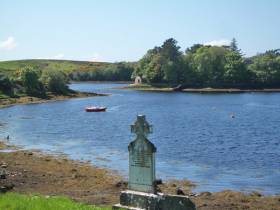Displaying items by tag: Burrishoole
#Angling - An angling bye-law focusing on salmon and sea trout has come into effect for Burrishoole, Co Mayo.
Sean Kyne, Minister of State with responsibility for Inland Fisheries, introduced the Conservation of Salmon and Sea Trout Shramore (Burrishoole)(Catch and Release) Bye Law No 951 into operation on Tuesday 13 June.
The new bye-law provides for catch and release angling for salmon and sea trout over 40cm in length in the Shramore (Burrishoole) system, and applies to Lough Furnace and the Seven Arch Bridge on the L5435 (old Newport Road).
Operative from Wednesday 14 June till Saturday 30 September, the bye-law and provides for the use of single barbless hooks while prohibiting the use of worms as bait in angling for salmon and sea trout.
‘Catch and release’ angling refers to the method of carefully handling any fish caught and immediately returning the fish alive to the water. This form of angling has a significant positive impact on the survival rate of released fish.
In addition, salmon and sea trout caught by fly fishing using single barbless hooks have a greater chance of survival than fish caught on barbed hooks. Barbless hooks do less damage, are easier to remove and reduce handling time which can be an important factor influencing survival.
Salmon and sea trout are some of Ireland’s main wild fish species attracting domestic and overseas anglers alike. Angling contributes €836 million to the Irish economy annually and supports upwards of 11,000 jobs which are often in rural communities.
Dr Ciaran Byrne, chief executive of Inland Fisheries Ireland, said: “Our salmon and sea trout stocks are extremely valuable. These new measures at Shramore, Burrishoole, will allow us to introduce a number of important methods which will help us protect these populations into the future.”
Anglers are requested to familiarise themselves the details of the new bye-law, available as a PDF to read or download HERE.
#warmlkake – A lake in county Mayo is among a number of lakes around the world that are 'warming' and Irish Marine Scientists are part of a global research project examining the trend.
Data for Lough Feeagh, situated in the Burrishoole catchment in Co. Mayo, forms part of the data, and is one of a small number of lakes worldwide for which long-term temperature data are available.
A temperature recorder on Lough Feeagh was originally installed in 1960, when the Salmon Research Trust of Ireland began investigations into the movement of salmon, trout and eel through the catchment.
The magnitude and uniformity of the worldwide trend remains unclear but to facilitate research on this topic, a global database of summer temperatures for 291 lakes from 1859-2009 has been compiled, complemented by data on local climatic drivers and lake geomorphology.
The paper describing lakes as sentinels of climate change is published in the Journal of Scientific Data, by Nature (http://www.nature.com/sdata/) on the 17th March 2015. Dr Elvira de Eyto, Marine Institute and co author on the paper along with Marine Institute scientists are part of the Global Lake Temperature Collaboration (GLTC), an international group assembled to provide increased access to global lake temperature records.
The GLTC project recognised that a new global database of lake surface temperatures was needed, including not only satellite data, but also "on the ground" measurements from in situ data collection programs. Since its
inception in 2010, the GLTC initiative has grown to a database of 291 lakes and reservoirs worldwide, providing summer-mean lake surface temperatures from 1985-2009, and roughly doubling the amount of data previously available from satellites alone. This new dataset represents the first publicly available global compilation of in situ and satellite-based lake surface temperature data. The GLTC database also provides information on climatic drivers (air temperature, solar radiation, cloud cover), as well as geomorphometric characteristics that may affect lake temperature (latitude, longitude, elevation, lake surface area, maximum depth, mean depth, volume).
This unique, global dataset will offer an invaluable baseline perspective on lake thermal conditions for ongoing and future studies of environmental change. The Marine Institute continues this work, and maintains an extensive environmental monitoring programme in the catchment which is used to record climate and land use changes that may impact fish stocks.






























































